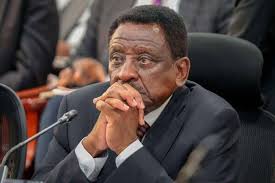AUSTINE OGOLA, THE POLITICAL BAROMETER: Siaya Governor, James Orengo leveraged the ODM’s 20th-anniversary celebrations in Mombasa to deliver one of the party’s clearest political signals in recent months: ODM is not preparing to retreat, merge, or be absorbed into the government’s broad-based arrangement.
Instead, the party is determined to reassert its identity, discipline its ranks, and re-enter the national conversation with renewed confidence ahead of the 2027 elections.
Orengo’s speech, delivered before party leaders and loyalists, was a sharp rebuke of ODM figures who have been warming up to President William Ruto’s administration.
With a tone both defiant and ideological, he insisted that it is the government, not the opposition, that stands to gain more from cooperation.
His now widely circulated line, “Ruto needs ODM, not the other way round,” strategically flipped the recent narrative that ODM must rely on State House access to stay relevant.
The statement was both symbolic and strategic: a reminder that ODM still possesses an extensive grassroots network, a recognizable ideology, and a history of political struggle that sets it apart from Kenya’s fast-changing coalition politics.
Political ‘cowards‘
A key aim of Orengo’s speech was internal, as he accused some ODM members of acting timidly and behaving as though the party’s survival depends on the goodwill of the government.
Though he did not name names, his remarks were clearly directed at elected leaders who have lately crossed into the State House orbit.
By calling such tendencies “cowardly,” Orengo was attempting to restore discipline and draw a clear line between ODM’s official position and the personal interests of individual politicians.
This comes at a time when internal party coherence is under strain, with delayed internal elections and the absence of Raila Odinga from day-to-day mobilization creating a vacuum.
Orengo’s message was, therefore, a warning that ODM cannot afford ideological drift.
Orengo also anchored his message in the legacy of Raila Odinga, describing ODM as a “people’s movement” and warning that liberation parties die when they forget their base.
His argument was that ODM’s durability stems from its connection to popular struggles rather than elite bargains.
Ultimate defiance
At a moment when the late Raila’s political future remains a subject of speculation, Orengo positioned himself among the custodians of the party’s historical identity.
This ideological framing was designed to counteract the narrative that ODM has reached the end of its ideological life cycle and must now survive through partnerships with the ruling coalition.
Instead, Orengo insisted that ODM’s relevance must be rebuilt from the bottom up.
Perhaps the most politically consequential part of the speech was Orengo’s declaration that ODM is capable of fielding its own presidential candidate in 2027.
This was a strong message in a season filled with speculation over whether ODM would support a joint opposition candidate or negotiate its place within a broader coalition structure.
Orengo’s position suggests that sections of ODM are unwilling to be junior partners in any emerging formation.
Whether the party can realistically mount a viable presidential run without Raila remains an open question, the statement was intended less as a final decision and more as a reassertion of confidence a reassurance to party supporters that ODM is not preparing to surrender its national stature.
Orengo’s speech complicates political calculations for both the ruling coalition and opposition parties. For President Ruto, the message signals resistance to his efforts to pull ODM leaders into his political orbit.
The statement challenges the impression that Western, Coast, and Nyanza politicians are drifting toward the government and reminds ODM supporters that cooperation is not the party’s official stance.
For other opposition players, particularly Wiper and Jubilee elements, Orengo’s declaration suggests that ODM intends to negotiate from a position of strength, potentially making alliance-building more complex.
However, Orengo’s hardline message also carries risks.
ODM risks alienating moderates who believe engagement with the government is essential for development.
The party could also isolate itself politically if it fails to assemble a broad coalition in 2027. Still, for ODM’s core support base, the speech was a reassurance that the party has not abandoned its identity or cause.
At a moment of widespread political realignment, Orengo sought to remind the country, and his party, that ODM’s foundation remains rooted in resistance, reform, and people-centered politics.
In conclusion, Governor Orengo’s Mombasa speech signals a deliberate shift: ODM intends to reclaim its voice as a bold, independent opposition party. Whether this rhetoric translates into electoral momentum or deepens internal divisions will become clear as the 2027 campaigns take shape. For now, Orengo has put the party on notice—and placed ODM firmly back into the center of Kenya’s political debate.

